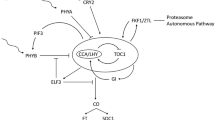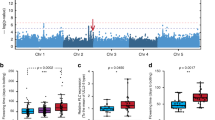Abstract
A segregating F2 population of Arabidopsis thaliana derived from a cross between the late-flowering ecotype Hannover/Münden (HM) and the early-flowering ecotype Wassilewskija (WS) was analyzed for flowering time and other morphological traits. Two unlinked quantitative trait loci (QTLs) affecting days to first flower (DFF-a and DFF-b) mapped to chromosome 5. QTLs which affect node number (NN), leaf length at flowering (LLF), and leaf length at 35 days (LL35) also mapped to chromosome 5; LLF-a, LL35-a, NN-a map to the same region of chromosome 5 as DFF-a; LLF-b and LL35-bmap to the same region of chromosome 5 as DFF-b. Another QTL affecting leaf length at flowering (LLF-c) maps to chromosome 3. The proximity of DFF-a, LLF-a, LL35-a and NN-a, as well as the similarity in gene action among these QTLs (additivity), suggest that they may be pleiotropic consequences of a single gene at this locus. Similarly, LL35-b and LLF-b map near each other and both display recessive gene action, again suggesting the possibility of pleiotropy. DFF-b, which also maps near LL35-b and LLF-b, displays largely additive gene action (although recessive gene action could not be ruled out). This suggests that DFF-b may represent a different gene from LL35-b and/or LLF-b. DFF-a maps near two previously identified mutants: co (which also affects flowering time and displays gene action consistent with additivity) and flc. Similar map locations and gene actions of QTLs affecting the correlated traits DFF, LLF, LL35 and NN suggest that these genomic regions harbor naturally occurring allelic variants involved in the general transition of the plant from vegetative to reproductive growth.
Similar content being viewed by others
References
Anderson M, Mulligan B (1992) Arabidopsis mutant collection. In: Koncz C, Chua NH, Schell J (eds) Methods in Arabidopsis research. World Scientific, Singapore, pp 419–437
Arumuganathan K, Earle ED (1991) Nuclear DNA content of some important plant species. Plant Mol Biol Rep 9:208–218
Atchley WR, Rutledge JJ, Cowley DE (1982) A mutivariate statistical analysis of direct and correlated response to selection in the rat. Evolution 36:677–698
Bernatzky RB, Tanksley SD (1986) Toward a saturated linkage map in tomato based on isozymes and random cDNA sequences. Genetics 112:887–898
Bradley D, Pruitt RE (1992) Development genetics of Arabidopsis. In: Russo VEA, Brody S, Cove D, Ottolenghi S (eds) Development the molecular genetic approach. Springer-Verlag, Berlin Heidelberg, pp 225–241
Cetl I, Plchova Z (1975) Arabidopsis thaliana (L.) HEYNH. as an object for studying population structure of predominantly self-pollinating plant species. Arabidopsis Inform Serv 12:35–38
Cetl I, Dobrovolna J, Effmertova E (1967) The role of the temperature factor in the geographical distribution of “summer annual” and “winter annual” natural populations of Arabidopsis thaliana (L.) Heynh. Arabidopsis Inf Serv 4:9–10
Chang C, Bowman JL, DeJohn AW, Lander ES, Meyerowitz EM (1988) Restriction fragment length polymorphism linkage map for Arabidopsis thaliana. Proc Natl Acad Sci USA 85:6856–6860
Clarke JH, Dean C (1994) Mapping FRI, a locus controlling flowering time and vernalization response in Arabidopsis thaliana. Mol Gen Genet 242:81–89
Dorn LA, Mitchell-Olds T (1991) Genetics of Brassica campestris. 1. Genetic constraints on evolution of life-history characters. Evolution 45:371–379
Edwards MD, Stuber CW, Wendel JF (1987) Molecular-markerfacilitated investigations of quantitative trait loci in maize. I. Numbers, genomic distribution, and types of gene action. Genetics 116:113–125
Feinberg AP, Vogelstein S (1984) A technique for radiolabelling DNA restriction endonuclease fragments to high specific activity (addendum). Anal Biochem 137:266–267
Griffing B, Scholl RL (1991) Qualitative and quantitative genetic studies of Arabidopsis thaliana. Genetics 129:605–609
Hartl DL, Clark AG (1988) Principles of population genetics, 2nd edn. Sinauer Associates, Sunderland, Massachusetts, p 492
Hauge BM, Hanley SM, Cartinhour S, Cherry JM, Goodman HM, Koornneef M, Stam P, Chang C, Kempin S, Medrano L, Meyerowitz EM (1993) An integrated genetic/RFLP map of the Arabidopsis thaliana genome. Plant J 3:745–754
Jones ME (1971) The population genetics of Arabidopsis thalianaII Population structure. Heredity 27:51–58
Karlovska' V (1974) Genotypic control of the speed of development in Arabidopsis thaliana (L.) Heynh. lines obtained from natural populations. Biol Plantar 16:107–117
Keim P, Diers BW, Olson TC, Shoemaker RC (1990) RFLP mapping in soybean: association between marker loci and variation in quantitative traits. Genetics 126:735–742
Kennard WC, Slocum MK, Figdore SS, Osborn TC (1994) Genetic analysis of morphological variation in Brassica oleracea using molecular markers. Theor Appl Genet 87:721–732
Koornneef M, Oresselhuys HC, Ramulu S (1982) The genetic identification of translocations in Arabidopsis. Arabidopsis Inf Serv 19:93–99
Koornneef M, Hanhart CJ, van der Veen JH (1991) A genetic and physiological analysis of late flowering mutants in Arabidopsis thaliana. Mol Gen Genet 229:57–66
Kosambi DD (1944) The estimation of map distances from recombination values. Ann Eugen 12:172–175
Kranz AR, Kirchheim B (1987) Genetic Resources in Arabidopsis. Arabidopsis Inf Serv: pp 3.2. 52, 3.2. 107
Lander ES, Botstein D (1989) Mapping Mendelian factors underlying quantitative traits using RFLP linkage maps. Genetics 121:185–199
Lander ES, Green P, Abrahamson J, Barlow A, Daly MJ, Lincoln SE, Newburg L (1987) MAPMAKER: an interactive computer package for constructing primary genetic linkage maps of experimental and natural populations. Genomics 1:174–181
Landry BS, Hubert N, Crete R, Chiang MS, Lincoln SE, Etoh T (1992) A genetic map for Brassica oleracea based on RFLP markers detected with expressed DNA sequences and mapping of resistance genes to race 2 of Plasmodiophora brassicae (Woronin). Genome 35:409–420
Lee I, Bleecker A, Amasino R (1993) Analysis of naturally occurring late flowering in Arabidopsis thaliana. Mol Gen Genet 237:171–176
Lincoln SE, Daly MJ, Lander ES (1993) Mapping genes controlling quantitative traits using MAPMAKER/QTL version 1.1: a tutorial and reference manual. Whitehead Institute for Biomedical Research, Whitehead Institute, Cambridge, Mass
Meyerowitz EM, Bowman JL, Chang C, Kempin S (1990) RFLP map of Arabidopsis thaliana (2N=10). In: O'Brien SJ (ed) Genetic maps: locus maps of complex genomes, 5th edn. Cold Spring Harbor Laboratory Press, Cold Spring Harbor, New York, pp 6.98–6.99
Michaels S, Lee I, Gore S, Amasino R (1993) Identification of a new late flowering locus: FLC. The Fifth International Conference on Arabidopsis Research, abstract 172
Napp-Zinn K (1985) Arabidopsis thaliana. In: Halvey HA (ed) Handbook of flowering, vol 1. CRC Press, Boca Raton, Florida, pp 492–503
National Climatic Center (1979) World weather records 19611970, vol 2, Europe. US Department of Commerce, National Oceanic and Atomospheric Administration, Asheville, N.C., pp 102, 384
Paterson AH, Lander ES, Hewitt JD, Peterson S, Lincoln SE, Tanksley SD (1988) Resolution of quantitative traits into Mendelian factors, using a complete linkage map of restriction fragment length polymorphisms. Nature 335:721–726
Paterson AH, Damon S, Hewitt JD, Zamir D, Rabinowitch HD, Lincoln SE, Lander ES, Tanksley SD (1991) Mendelian factors underlying quantitative traits in tomato: comparison across species, generations, and environments. Genetics 127:181–197
Paterson AH, Tanksley SD, Sorrells ME (1992) DNA markers in crop improvement. In: Sparks DL (ed) Advances in Agronomy. Academic Press, New York, pp 39–90
Ramula KS, Sybenga J (1985) Genetic background damage accompanying reciprocal translocations induced by X-rays and fission neutrons in Arabidopsis and Secale. Muta Res 149:421–430
Redei GP (1962) Supervital mutants of Arabidopsis. Genetics 47:443–460
Reed KC, Mann DA (1985) Rapid transfer of DNA from agarose gels to nylon membranes. Nucleic Acids Res 13:7207–7221
Rhoades MM (1933) A cytogenetical study of a reciprocal translocation in zea. Proc Natl Acad Sci USA 19:1022–1031
Sambrook J, Fritsch EF, Maniatis T (1989) molecular cloning: a laboratory manual 2nd edn. Cold Spring Harbor Laboratory Press, Cold Spring Harbor, New York
Sax K (1923) The association of size differences with seed-coat pattern and pigmentation in Phaseolus vulgaris. Genetics 8:552–560
Snedecor GW, Cochran WG (1989) Statistical methods, (8th edn.). Iowa State University Press. Ames, Iowa, pp 79–81
Strickberger MW (1968) Genetics. Macmillan, New York, pp 495–501
Stuber CM, Edwards M, Wendel JF (1987) Molecular-marker facilitated investigations in maize. 11. Factors influencing yield and its component traits. Crop Sci 27:639–648
Stuber CW, Lincoln SE, Wolff DW, Helentjaris T, Lander ES (1992) Identification of genetic factors contributing to heterosis in a hybrid from two elite maize inbred lines using molecular markers. Genetics 132:823–839
Thoday JM (1961) Location of polygenes. Nature 191:368–370
Wang GL, Mackill DJ, Bonman JM, McCouch SR, Nelson RJ (1993) RFLP mapping of genes conferring complete and partial resistance in a rice cultivar with durable resistance to blast. In: Jacobs T, Parlevliet JE (eds) Durability of disease resistance. Kluwer Academic Publishers, The Netherlands, pp 209–215
Weller JI, Soller M, Brody T (1988) Linkage analysis of quantitative traits in an interspecific cross of tomato (L. esculentum x L. pimpinellifolium) by means of genetic markers. Genetics 118:329–339
Westerman JM (1971a) Genotype-environment interaction and developmental regulation in Arabidopsis thaliana, III. Inbred lines; analysis of response to photoperiod. Heredity 26:373–382
Westerman JM (1971b) Genotype-environment interaction and developmental regulation in Arabidopsis thaliana, IV Wild material; analysis. Heredity 26:383–395
Wright JE Jr, Johnson K, Hollister A, May B (1983) Meiotic models to explain classical linkage, pseudolinkage, and chromosome pairing in tetraploid derivative salmonid genomes. Isozymes Curr Top Biol Med Res 10:239–260
Zagotta MT, Shannon S, Jacobs C, Meeks-Wagner DR (1992) Early-flowering mutants of Arabidopsis thaliana. Aust J Plant Physiol 19:411–418
Author information
Authors and Affiliations
Additional information
Communicated by H. Saedler
Rights and permissions
About this article
Cite this article
Kowalski, S.P., Lan, TH., Feldmann, K.A. et al. QTL mapping of naturally-occurring variation in flowering time of Arabidopsis thaliana . Molec. Gen. Genet. 245, 548–555 (1994). https://doi.org/10.1007/BF00282217
Received:
Accepted:
Issue Date:
DOI: https://doi.org/10.1007/BF00282217




